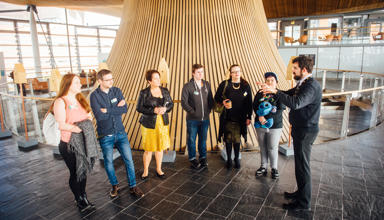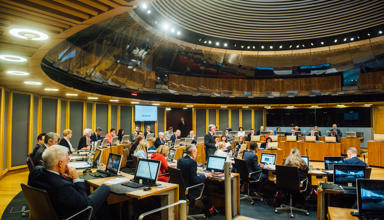Law making and government in Wales has changed significantly over the years. Here is a brief overview.
950-1450
Wales has its own native law-making tradition which can be traced back to the mid 10th century. Hywel Dda (Hywel the Good) is reputed to have overseen the codification and re-ordering of Welsh law during this period. However, the failure of the final great rebellion led by Owain Glyndŵr (1400-c.1415), a popular leader who organised parliaments in Machynlleth and Harlech, brought an end to native Welsh law.
1535-1542
During the reign of Henry VIII the Laws in Wales Acts 1535 and 1542 were passed. The Acts annexed Wales to the Kingdom of England. The Act extended English law to Wales, and specified English as the language of the law, though it established separate judicial structures for Wales in the Court of Great Sessions. There were 26 (rising to 27) Members of Parliament for Wales in the English Parliament.
When the United Kingdom was formed in 1707, the English and Scottish Parliaments were dissolved and a new Parliament of Great Britain was formed. In 1801, this expanded to include Ireland, becoming the Parliament of the United Kingdom
In 1746 the Wales and Berwick Act changed the legal definition of England to include Wales (and Berwick). In 1830 the Court of Great Sessions was abolished, removing the last recognisable distinctive feature of law in Wales.
1880-1921
The roots of political devolution in Wales can be traced to the end of the nineteenth century. In 1886, Cymru Fydd (Young Wales) was established to promote the objectives of the Liberal Party in Wales and to campaign in favour of Welsh ‘home rule’. In 1881 a specifically Welsh Act (the Sunday Closing Act) was passed in the UK Parliament for the first time. The twentieth century saw the beginning of administrative devolution in Wales through the creation of the Welsh Board for Education in 1907 and eventually in 1920, the disestablishment of the Anglican church in Wales.
Various schemes for ‘home rule all round’ were proposed between the 1880s and the outbreak of World War I. These envisaged the creation of parliaments and governments in Dublin, Edinburgh and Cardiff, all belonging to the British Empire. The establishment of the Irish Republic, and the partition of Ireland under the premiership of the first Prime Minister from Wales, David Lloyd George, ended this phase in the history of devolution.
1940s and 50s
In the early 1950s the Parliament for Wales campaign put devolution back onto the political agenda. This cross-party campaign, led by Lady Megan Lloyd George, culminated in the presentation of a petition containing 250,000 signatures calling for the establishment of a Welsh parliament.
A series of developments started the process of shifting powers from Westminster to Wales.
Petitions to create a Secretary of State for Wales were turned down by the Labour Government of 1945-50, which, as a substitute, created a Council for Wales and Monmouthshire in 1948. This was an unelected body that advised the government on Welsh affairs.
In 1951, the Conservative Government created a new junior Home Office Minister of Welsh Affairs . The post was upgraded to Minister of State in 1954.
1960s
Following the 1964 UK election, the new Labour government created the office of Secretary of State for Wales.
The following year the Welsh Office, headed by the new Secretary of State, was established to execute UK Government policy in Wales.
At first, the Secretary of State only had responsibility for housing, local government and roads. Other areas including education and training, health, trade and industry, and the environment and agriculture were gradually added over the years.
1965 also saw the Welsh speaking village of Capel Celyn in the Afon Tryweryn Valley submerged under the newly formed Tryweryn reservoir. In order to provide a new water supply for Liverpool, Liverpool City Council obtained authority via an Act of UK Parliament to create a reservoir on the site of the village. As a result, Liverpool City Council did not require planning consent from the relevant Welsh local authorities and also avoided a planning inquiry which would have enabled arguments against the proposal to be made at a Welsh level. This process and the fact that the village was one of the last Welsh-only speaking communities, meant that the creation of the reservoir and the consequent destruction of the village was extremely controversial.
The Welsh Language Act 1967 repealed part of the Wales and Berwick Act to remove Wales from the legal definition of England. It also expanded areas where use of Welsh was permitted, including in some legal situations.
1970s
The 1970s saw a prolonged parliamentary battle over the establishment of devolution to Wales and Scotland. The Labour Government of 1977-79 faced ongoing opposition from within its own party to its plans for devolution, but was kept in power through the support of, among others, nationalist MPs from Wales and Scotland.”
The 1973 Royal Commission on the Constitution, chaired first by Lord Crowther and subsequently by Lord Kilbrandon, recommended the creation of elected bodies for Scotland and Wales. A referendum on the proposal was held in Wales on St David’s Day in 1979. Despite the proposal having been put forward by the UK Labour Government, opposition was spearheaded by members of the Labour Party. The proposal was rejected in Wales by a majority of 4 to 1. For many, this appeared to be the end for devolution in Wales..
1979-1997
In the immediate aftermath of the 1979 referendum, devolution became something of a dormant political issue in Wales. However, the policies of the UK Conservative Government during the difficult economic conditions of the 1980s, coupled with the Conservative Party’s relatively low levels of electoral support in Wales (in contrast with the UK as a whole), led to renewed calls for Wales to have its own democratic institution.
The powers of the Welsh Office had been markedly increased in the lead up to the referendum, a process which continued through the years of Margaret Thatcher as Prime Minister.
This process also saw the creation and expansion of the quangos (quasi non-governmental organisations). These were arms-length bodies to which government powers were delegated. The UK Government retained a degree of control, with the Secretary of State for Wales appointing much of the leadership of quangos. Demand grew for greater accountability and democratisation of this layer of government.
The Welsh Language Act 1993 put Welsh on an equal legal footing to English in much of public life, and repealed the 16th century Laws in Wales Acts.
1997 -1998
Welsh support for devolution had increased during the 1980s and 1990s, and in May 1997 the incoming Labour Government’s manifesto included commitments to hold referendums on the creation of devolved administrations in Wales and Scotland. Following the publication of a White Paper, A Voice for Wales, in July 1997, a referendum was held on 18 September 1997. The result was 50.3 per cent in favour, and 49.7 per cent against: a majority of just 6,721. However, this was enough to change the course of Welsh history. Ron Davies, then Secretary of State for Wales, described devolution as “a process, not an event”. This has been borne out by developments in Welsh devolution since 1997
In 1998 the UK Parliament passed the Government of Wales Act, providing the legal basis for the National Assembly for Wales. The legislation included a number of core values, including a commitment to equality, sustainable development, partnership working and parity of treatment for both the Welsh and English languages. The Act granted the National Assembly the power to make secondary legislation in specified areas, including agriculture, fisheries, education, housing and highways. Such powers were broadly equivalent to those previously held by the Secretary of State for Wales.
1999
The National Assembly for Wales met for the first time on 12 May 1999. It was officially opened by the Queen on 26 May. Of the 60 newly-elected Members, 24 were women. This represented a significant change in the previously male-dominated Welsh politics.
2000 - 2006
The newly-established Assembly was based on a more inclusive and consensual style of politics, and prioritised public access to its work. However, its structure as a single corporate body responsible for executive and scrutiny functions proved to be problematic. The minority Labour administration experienced difficulties in securing agreement from other parties, and the First Secretary was replaced in February 2000.
In response to increasing calls for change, the Assembly resolved in 2002 to separate the functions of executive and legislature. The term ‘Welsh Assembly Government’ began to be used to describe the policies and actions of the Cabinet, allowing the term ‘National Assembly’ to refer to the scrutiny, representative and legislative work of the legislature.
In 2002, the Commission on the Powers and Electoral Arrangements of the National Assembly for Wales was established. Known as the Richard Commission, in 2004 it recommended the legal separation of the executive and legislature as individual legal entities, the devolution of primary law-making powers to Wales, and an increase in the number of Members.
The majority of the Richard Commission’s recommendations were accepted by the UK Government, and given effect by the Government of Wales Act 2006.
The Senedd building was opened by the Queen on St David’s Day 2006. Designed by the Richard Rogers Partnership, the building makes extensive use of Welsh materials like slate and oak. It also embodies in physical form the values that underpinned the National Assembly, including environmental sustainability, transparency, and openness.
2007
Following the third Welsh General Election, Assembly Members met in a National Assembly that had been formally separated from the Welsh Government by the Government of Wales Act 2006. This new settlement also gave the Assembly the power to make primary legislation for the first time.
Through separation, the 2006 Act clarified the roles of each institution. The National Assembly made laws and represents the interests of the people of Wales. The Welsh Government (the First Minister, the Welsh Ministers, Deputy Ministers and the Counsel General) became responsible for making and implementing decisions, policies and subordinate legislation.
The Welsh Government’s decisions and actions are kept in check by the National Assembly (the body of 60 elected Members) which holds the Welsh Government to account.
The 2006 Act also provided that the property, staff and services required by the National Assembly would be provided by the Assembly Commission.
2011 - 2014
On 4 March 2011 the Welsh electorate voted in a third devolution referendum, this time on whether or not full primary law-making powers should be extended to the National Assembly in those areas over which it had responsibility. This time 63.5% of voters supported further devolution. ‘Home rule’ had come of age.
The UK Government established the Commission on Devolution in Wales, known as the Silk Commission, to consider the future of the devolution settlement in Wales. In 2012, the Silk Commission published Part I of its report, making recommendations on the financial powers of the Assembly. The Silk Commission published Part II of its report in 2014, making recommendations on the Assembly’s future legislative powers and arrangements.
As a result of the Part I report, the UK Government introduced the Wales Act 2014 which bestowed a number of new financial powers on Wales, including taxation and borrowing powers.
2015 – 2016
The UK Government published Powers for a Purpose in 2015, providing the basis for the development of a reserved powers model of devolution for Wales.
The Assembly passed the Tax Collection and Management (Wales) Act 2016, in preparation for exercising the powers devolved by the Wales Act 2014. This period also saw the start of the Assembly’s role in scrutinising relevant legislation and the UK’s negotiations for leaving the EU, and defining Wales’s place in a post-Brexit UK.
2017
The Wales Act 2017 established the National Assembly on a new constitutional basis, making it a permanent part of the UK constitution. The 2017 Act moved the Assembly from the conferred powers model to the reserved powers model. Among the new powers Wales’ devolved legislature had responsibility for was the power to decide its own name and the voting system by which its Members are elected.
2018
In April 2018 the first two devolved Welsh taxes were introduced - the Land Transaction Tax, which replaced Stamp Duty, and Landfill Disposals Tax. This was followed in April 2019 by the devolution of control over £2 billion of income tax. These taxes are now subject to the agreement of the Senedd.
2019
In February 2019 members of the Welsh Youth Parliament met for the first time in the Senedd chamber. Mirroring the election of Members of the Senedd, 40 members of the Youth Parliament are elected from every constituency in Wales with another 20 elected to ensure wider diversity and inclusivity.
2020
After 20 years, the National Assembly was recognised as a fully-fledged parliament after the Senedd and Elections (Wales) Act 2020 became law. This changed its name on 6 May 2020 to Senedd Cymru or Welsh Parliament to fully reflect its constitutional status as a law-making and tax-setting parliament. The 2020 Act also gave 16 and 17 year olds and qualified foreign nationals the right to vote in Senedd elections, the largest extension of the right to vote in 50 years.
2024
The Senedd Cymru (Members and Elections) Act officially became law on 24 June 2024.
The Act will increase the size of the Senedd and reform the voting system in Wales, reflecting how the role and responsibilities of the Senedd have grown over the past 25 years.
These changes mean that from the 2026 Senedd election, people in Wales will use the new voting system to elect 96 Members to represent 16 constituencies across the country.







